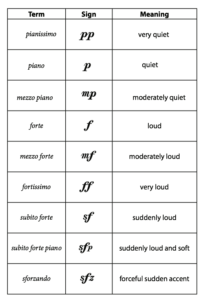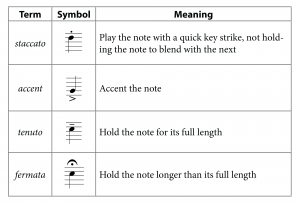Dynamics symbols tell how loud or quietly music should be played. These terms were brought into usage by Italian composers, and we still use the Italian terms and symbols. The terms are summarized in Table 3.11 along with the signs used to denote them on the staff. Additional ps and fs can be added to emphasize the loudness or quietness, but four ps or fs is usually the limit. The symbols are displayed below the staff in the area to which they are applied.

Gradual changes in dynamics are indicated by crescendo and decrescendo symbols (Figure 3.40). The decrescendo can also be called a diminuendo. The crescendo indicates that the music should gradually grow louder. The decrescendo is the opposite. These symbols can be made longer or shorter depending on the time over which the change should occur. They are usually placed below the staff, but occasionally above.

Articulation marks (Table 3.12) indicate the manner in which a note is to be performed. A little dot above or below a note (depending on the direction of the note’s stem) indicates that it is to be played staccato – that is, played as a short note not held down and thus not linked directly in sound to the next note. A “greater than” sign above or below a note, called an accent, indicates that the note should be played louder, with special emphasis. A straight line above or below a note, called tenuto, emphasizes that a note is to be held for its full value. A dot with a semicircle above it, called a fermata, means that a note is to be held longer than its normal value. The articulation marks and dynamics symbols help a composer to guide the style and technique applied to the performance of a composition.
